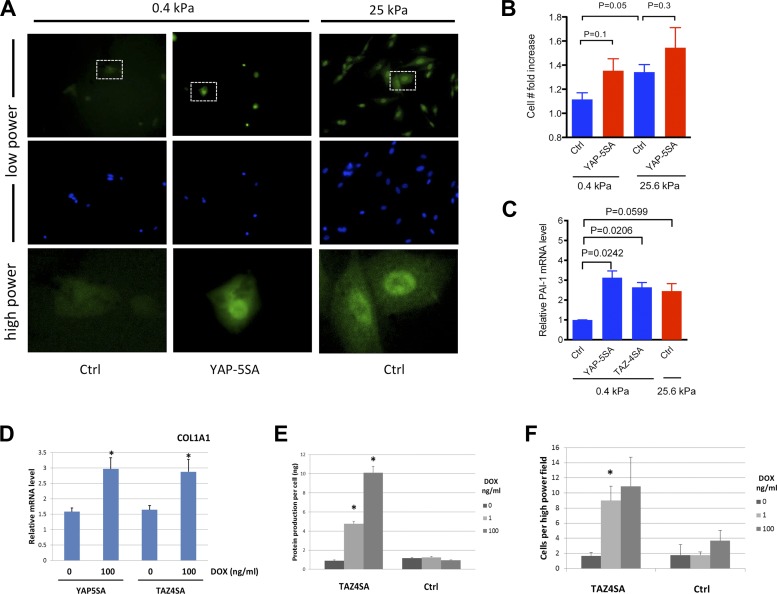Fig. 7.
Overexpression of YAP5SA or TAZ4SA promotes fibroblast proliferation and matrix synthesis. YAP5SA-expressing NIH3T3 fibroblasts exhibit nuclear YAP localization on soft (0.4 kPa) matrices comparable to control NIH3T3 cells grown on stiff (25 kPa) matrices. In contrast, control NIH3T3 cells exhibit little nuclear localization on soft matrices. Immunostaining performed with mouse anti-YAP (63.7) antibody (Santa Cruz Biotechnology, detects both YAP and TAZ) and Hoechst 33342. All cells exposed to 100 ng/ml doxycycline (DOX) for 48 h. Dashed boxes in top row indicate areas detailed under higher power in bottom row. B: YAP5SA-expressing NIH3T3 fibroblasts exhibit a trend toward enhanced proliferative capacity on soft matrix (0.4 kPa) comparable to that of control cells on stiff matrix (25 kPa). Data shown are fold increases in cell number relative to seeding density, n = 2 independent experiments. C: YAP5SA- and TAZ4SA-expressing NIH3T3 fibroblasts exhibit increased PAI-1 (SERPINE1) transcript levels on soft matrix (0.4 kPa) comparable to control cells on stiff matrix (25 kPa), as measured by qPCR normalized to GAPDH and 0.4 kPa control (Ctrl) samples, n = 2 independent experiments. D: doxycycline-induced YAP5SA or TAZ4SA expression augments expression of COL1A1 transcripts in NIH3T3 cells cultured 48 h on 25-kPa hydrogels. *P < 0.05 compared with 0 ng/ml doxycycline, unpaired t-test. E: doxycycline-induced TAZ4SA expression increases extracellular matrix protein deposition on a per-cell basis by NIH3T3 cells on gelatin-coated coverslips. *P < 0.05 compared with NIH3T3 control cells (Ctrl) treated with same dose doxycycline. F: naïve NIH3T3 adhesion is enhanced on matrices derived from doxycycline-treated TAZ4SA cells relative to control cells (Ctrl). *P < 0.05 compared with NIH3T3 control cells treated with the same dose of doxycycline.

